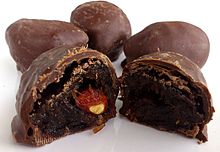Prune


A prune is a dried plum of any cultivar, mostly Prunus domestica or European Plum. The use of the term for fresh fruit is obsolete except when applied to varieties grown for drying.[1]
Most prunes are freestone cultivars (the pit is easy to remove), whereas most other plums grown for fresh consumption are clingstone (the pit is more difficult to remove).
Production
| Nutritional value per 100 g (3.5 oz) | |||||||||||||||||||||||||||||||||||||||||||||||||||
|---|---|---|---|---|---|---|---|---|---|---|---|---|---|---|---|---|---|---|---|---|---|---|---|---|---|---|---|---|---|---|---|---|---|---|---|---|---|---|---|---|---|---|---|---|---|---|---|---|---|---|---|
| Energy | 1,006 kJ (240 kcal) | ||||||||||||||||||||||||||||||||||||||||||||||||||
63.88 g | |||||||||||||||||||||||||||||||||||||||||||||||||||
| Sugars | 38.13 g | ||||||||||||||||||||||||||||||||||||||||||||||||||
| Dietary fiber | 7.1 g | ||||||||||||||||||||||||||||||||||||||||||||||||||
0.38 g | |||||||||||||||||||||||||||||||||||||||||||||||||||
2.18 g | |||||||||||||||||||||||||||||||||||||||||||||||||||
| |||||||||||||||||||||||||||||||||||||||||||||||||||
| Other constituents | Quantity | ||||||||||||||||||||||||||||||||||||||||||||||||||
| Water | 31 g | ||||||||||||||||||||||||||||||||||||||||||||||||||
| †Percentages estimated using US recommendations for adults,[2] except for potassium, which is estimated based on expert recommendation from the National Academies.[3] | |||||||||||||||||||||||||||||||||||||||||||||||||||
More than 1,000 plum cultivars are grown for drying. The main cultivar grown in the United States is the Improved French prune. Other varieties include Sutter, Tulare Giant, Moyer, Imperial, Italian, and Greengage. Fresh prunes reach the market earlier than fresh plums and are usually smaller in size.
Name
In 2001, plum growers in the United States were authorised by the government to call prunes "dried plums".[4] Due to the popular U.S. perception of prunes being used only for relief of constipation, and being the subject of related joking, many distributors stopped using the word "prune" on packaging labels in favour of "dried plums".[5]
Health effects
Prunes contain dietary fiber (about 7% per gram; table) which may provide laxative effects,[6] a conclusion reached in a 2012 review by the European Food Safety Authority demonstrating that prunes effectively contribute to the restoration of normal bowel function in the general population if consumed in quantities of at least 100 grams (3.5 oz) per day.[7]
Nutrition
Prunes are 31% water, 64% carbohydrates, including 7% dietary fiber, 2% protein, and less than 1% fat (table). Prunes are a rich source of vitamin K (57% of the Daily Value, DV) and a moderate source of several B vitamin and dietary minerals (10-16% DV; table).
Phytochemicals
Prunes and their juice contain phytochemicals, including phenolic compounds (mainly as neochlorogenic acids and chlorogenic acids) and sorbitol.[6]
Uses

Prunes are used in preparing both sweet and savory dishes.[7]
Contrary to the name, boiled plums or prunes are not used to make sugar plums which instead may be a nut, seed, or spice coated with hard sugar, also called a comfit.[8]
See also
References
- ^ "Dehydrated Prunes Grades and Standards". Agricultural Marketing Service, US Department of Agriculture. 2017. Retrieved 15 May 2017.
- ^ United States Food and Drug Administration (2024). "Daily Value on the Nutrition and Supplement Facts Labels". FDA. Archived from the original on 27 March 2024. Retrieved 28 March 2024.
- ^ National Academies of Sciences, Engineering, and Medicine; Health and Medicine Division; Food and Nutrition Board; Committee to Review the Dietary Reference Intakes for Sodium and Potassium (2019). Oria, Maria; Harrison, Meghan; Stallings, Virginia A. (eds.). Dietary Reference Intakes for Sodium and Potassium. The National Academies Collection: Reports funded by National Institutes of Health. Washington, DC: National Academies Press (US). ISBN 978-0-309-48834-1. PMID 30844154. Archived from the original on 9 May 2024. Retrieved 21 June 2024.
- ^ "FDA Approves Prune Name Change". ABC News. 6 January 2006. Retrieved 14 July 2016.
- ^ Janick, Jules and Robert E. Paull (2008). The Encyclopedia of Fruit and Nuts. CABI. ISBN 0-85199-638-8. p. 696.
- ^ a b Stacewicz-Sapuntzakis, M; Bowen, PE; Hussain, EA; Damayanti-Wood, BI; Farnsworth, NR (2001). "Chemical composition and potential health effects of prunes: a functional food?". Critical Reviews in Food Science and Nutrition. 41 (4): 251–86. doi:10.1080/20014091091814. PMID 11401245.
- ^ a b EFSA Panel on Dietetic Products, Nutrition and Allergies (NDA). "Scientific Opinion on the substantiation of health claims related to dried plums of 'prune' cultivars (Prunus domestica L.) and maintenance of normal bowel function (ID 1164, further assessment) pursuant to Article 13(1) of Regulation (EC) No 1924/2006". EFSA Journal. 10 (6). Parma, Italy: European Food Safety Authority (EFSA): 2712. doi:10.2903/j.efsa.2012.2712.
- ^ Kawash, Samira (22 December 2010). "Sugar Plums: They're Not What You Think They Are". The Atlantic. Retrieved 13 July 2017.
